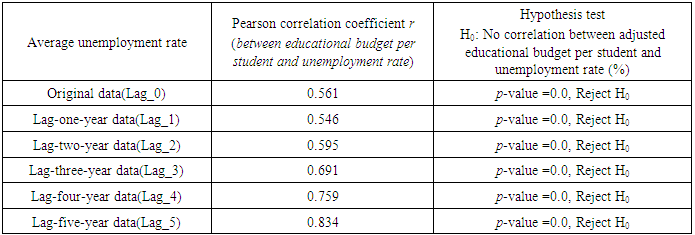-
Paper Information
- Next Paper
- Previous Paper
- Paper Submission
-
Journal Information
- About This Journal
- Editorial Board
- Current Issue
- Archive
- Author Guidelines
- Contact Us
American Journal of Economics
p-ISSN: 2166-4951 e-ISSN: 2166-496X
2016; 6(1): 15-21
doi:10.5923/j.economics.20160601.02

Can Increasing Educational Budget Reduce Unemployment Rate?
Ko-Ming Ni
Department of Information Management, Ling Tung University, Taiwan
Correspondence to: Ko-Ming Ni, Department of Information Management, Ling Tung University, Taiwan.
| Email: |  |
Copyright © 2016 Scientific & Academic Publishing. All Rights Reserved.
This work is licensed under the Creative Commons Attribution International License (CC BY).
http://creativecommons.org/licenses/by/4.0/

Intuition may tell you that increasing educational budget will reduce unemployment rate, hence, Taiwan’s Ministry of Education (MOE) provides subsidies and set an evaluation index to vocational schools, colleges, and universities based on the employment rate of their graduates. However, from objective data analyses, the author finds that there is positive correlation between educational budget and unemployment rate. The more the educational budget, the higher the unemployment rate will be. This phenomenon does not change when lagged-effect is considered. It means educational budget this year may have a correlation with unemployment rate for following one, two, three, four, or more years to come. From the study, the author also finds the positive correlation coefficient between the educational budget per student and unemployment rate. This phenomenon continues to exist by taking into consideration the lagged-effect. Although the unemployment rate counts the people aged 15 and above in Taiwan [2], and it may not be consistent with the educational budget per student, which takes students of all ages into account, the positive correlation still exists. Whether reducing educational budget has an effect on the unemployment rate is beyond the discussion in this paper due to the lack of objective data.
Keywords: Lagged-Effect, Educational Budget, Unemployment Rate
Cite this paper: Ko-Ming Ni, Can Increasing Educational Budget Reduce Unemployment Rate?, American Journal of Economics, Vol. 6 No. 1, 2016, pp. 15-21. doi: 10.5923/j.economics.20160601.02.
Article Outline
1. Introduction
- People who are available to work but unable to find jobs in the previous four weeks are unemployed [1]. Negative effects such as anxiety about future, lower living standard, without feeling of security may impact on those who lose their jobs. Hence, almost all governments around the world try their best to reduce the unemployment rate, which counts the ratio of those who lost jobs and population in labor force [1]. The labor force counts people aged 15and above who are available in the labor market in Taiwan[2]and it is slightly different from the USA, which calculates people aged 16 and above in the labor market [1,4]. The government of Taiwan also tries to use all means to reduce the unemployment rate. Monetary and fiscal policies are usually used to revive a dimming economy. And international cooperation such assigning free trade agreement (FTA) may also be a way to reduce trade barrier with each other. But what is the role of education in the labor market? Can a good educational system help a government to reduce the unemployment rate? It is the issue to be discussed in this paper.This paper is inspired by two observations. The first one is that the educational system in the United States of America is much better than Taiwan, especially in higher education, otherwise, why are there so many international students from around the world flocking in USA to get degrees there? It estimates that between 2008 and 2012, foreign students contributed US$21.8 billion in tuition fees and US$12.8 billion in living costs to 118 metro areas [5]. In 2014, international students contributed more than US$27 billion to the America economy, according to the U.S. Department of Commerce [8]. The second inspiration is that the Ministry of Education (MOE) of Taiwan lists the “employment rate” of students graduated from colleges and universities to be an index in evaluating the teaching proficiency of a school and be a parameter for subsidizing vocational schools, colleges, and universities [3]. The fundamental thinking of MOE may be that if a school can manage its resources well, then it can produce graduates with good quality, and to find a job more easily. Therefore, the unemployment rate will be reduced. Will such chain effects work? The author tries to explore this problem in an objective way and to find the relationships between education quality and unemployment rate. Because of the quality of education is difficult to measure, the author assumes that the educational budget may can somehow reflect the goodness of quality. If increasing educational budget can reduce unemployment rate, then the government should increase budget on education. On the contrary, if the unemployment rate has no or little correlation with educational budget, then the requirements from MOE are groundless and should be scrapped out from its policy as well as removed from the list of evaluation index.To find the correlation between the educational budget of Taiwan and unemployment rate, the data from DGBAS [2] are used in the analysis. The statistic and graphing software used in this paper is Minitab.
2. Unemployment Rate and Educational Budget
- The unemployment rates of Taiwan recorded in DGBAS [2] are from 1978 to 2014, and the corresponding unemployment data in the USA are obtained from the Labor of Statistics [4].
2.1. Educational Budget Adjusted by Consumer Price Index (CPI)
- Since education is an item in the “basket” of consumer spending [1], in this study, the author adjusts the educational budget with the consumer price index (CPI) which takes 2011 as the base year. The original, adjusted educational budget as well as CPI values are as in Table 1 [2].
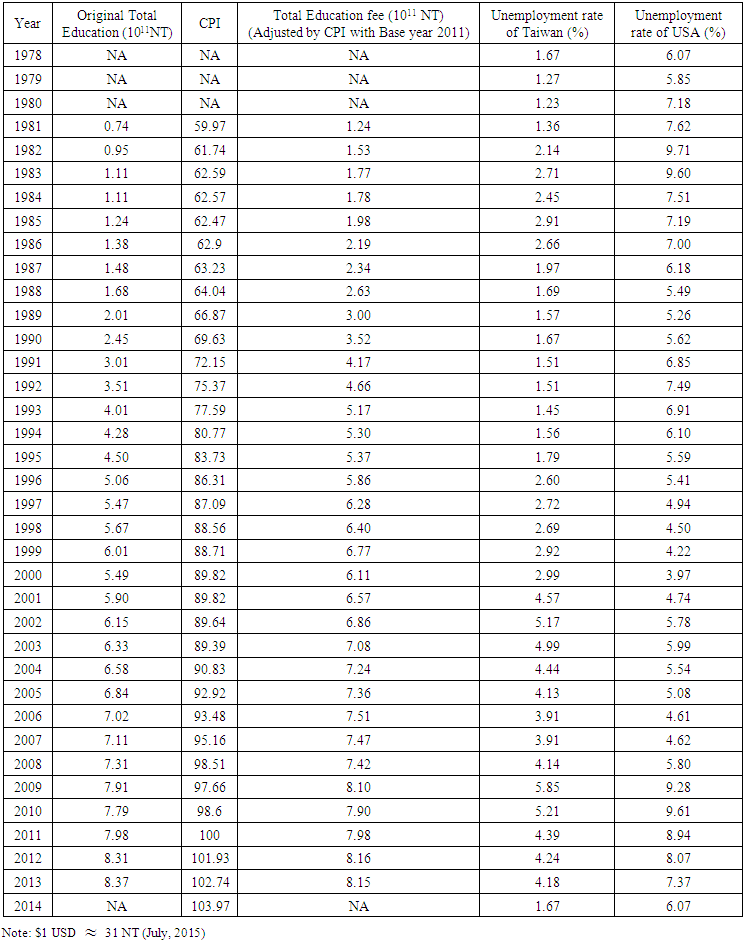 | Table 1. The total educational budget (in  NT) and unemployment rate [2, 4] NT) and unemployment rate [2, 4] |
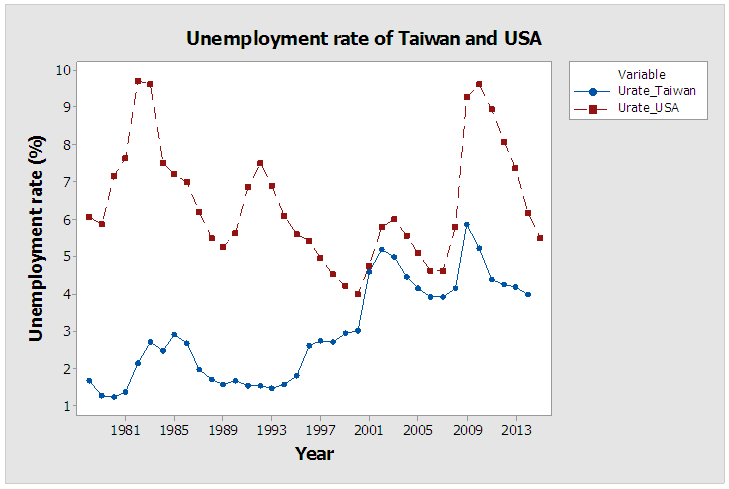 | Figure 1. Yearly unemployment rate of Taiwan and the United States of America from 1978 to 2014 |
2.2. Correlation between Educational Budget and Unemployment Rate
- The author considers the lagged-effect should be discussed to make the unemployment rate and educational budget correlation more reasonable. The lagged-effect means the spending on educational budget this year does not seem to have a reasonable effect on the unemployment of the same year. Rather, it may have a correlation with the unemployment rate in a few years to come. Students should spend three years in senior high schools and four years in colleges or universities, hence, there shall be some correlation with the unemployment rate in the following one, two, three or more years to come if the assumption of educational budget-unemployment rate relationship exists.The educational budget and unemployment rate are assumed to have time difference. Lag_0 means the educational budget influences the unemployment rate of the same year; Lag_1 means educational budget this year may influence unemployment rate of the next year; Lag_2 to Lag_4 follow the same explanation.
2.2.1. Unemployment Rate and Educational Budget with Lagged-Effect
- The relationship between original educational budget (Lag_0) and unemployment rate is shown in Figure 2.
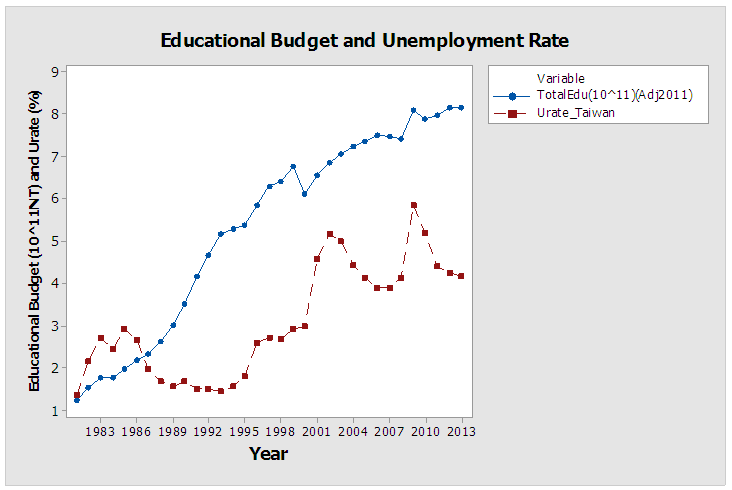 | Figure 2. Educational budget ( NT) and unemployment rate (%) from years 1978 to 2013 NT) and unemployment rate (%) from years 1978 to 2013 |
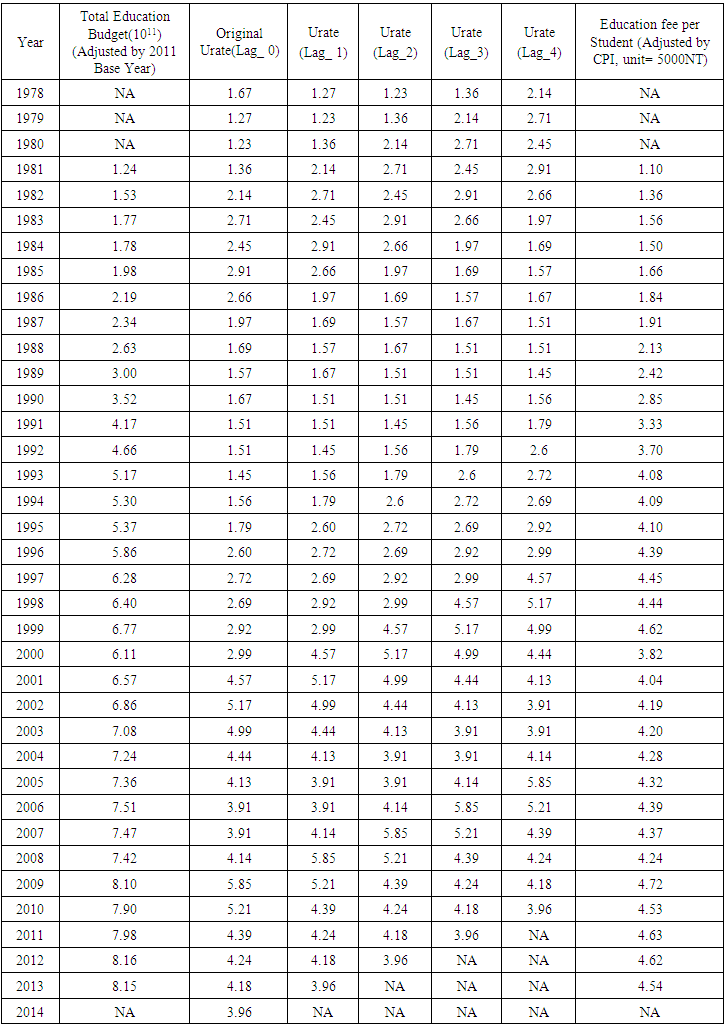 | Table 2. The adjusted educational budget and unemployment rate with lagged-effect |
|
2.2.2. Educational Budget per Student and Unemployment Rate
- This subsection checks the relationship of the unemployment rate and educational fee per student. If each student can share more budget, it means the more resources, better quality, easier to find a job after graduation, and may reduce unemployment rate. The educational budget per student and unemployment rate with no lagged-effect (Lag_0) is shown in Figure 3.
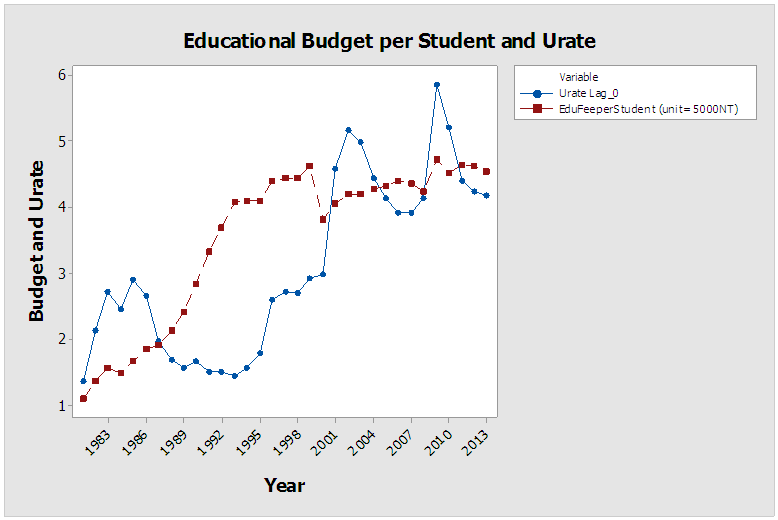 | Figure 3. Educational budget per student (unit =5000 NT) and unemployment rate (%) with no lagged-effect (Lag_0) |
|
3. Conclusions
- After the above objective analyses, some observations can be obtained:(1) The unemployment rate of the United States of America is higher than that of Taiwan in each year from 1978 to 2014. Although the educational system in USA is better than Taiwan, especially in higher education, the average unemployment rate there is 2.16 times than that in Taiwan. It means, the better educational system does not necessarily have lower unemployment rate.(2) The Pearson correlation coefficient between educational budget, which has been adjusted by the CPI value with the base year 2011, and unemployment rate is positive. In other words, the higher the educational budget, the higher the unemployment rate will be in Taiwan. This observation is quite different from one’s intuition.(3) The lagged-effect is considered in the study of the educational budget and unemployment rate. It means that the educational fee spent on this year may have a correlation with the unemployment rate of the following few years. The Pearson correlation coefficients are positive from zero to five lag-years. (4) Educational budget per student also has a positive Pearson correlation with the unemployment rate. The author takes the lagged-effect into consideration, the positive correlation exists from zero to five years. The more the educational budget on each student, the higher the unemployment rate will be. Even though the unemployment rate counts people aged 15 and above, instead, the educational budget per student takes all students into consideration, the positive correlation still exists.(5) If increasing educational budget alone cannot reduce Taiwan’s unemployment, it is suggested Taiwan’s relevant government agencies find out the factors involved and seek other effective solutions. As for the impact of reducing educational budget on the unemployment rate is not studied due to the lack of objective data.
 Abstract
Abstract Reference
Reference Full-Text PDF
Full-Text PDF Full-text HTML
Full-text HTML
